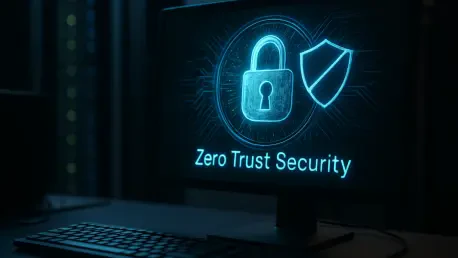In the rapidly evolving landscape of cybersecurity, the Zero Trust model has emerged as a cornerstone for securing enterprises against sophisticated threats. However, despite its widespread adoption, a significant number of organizations may not fully implement Zero Trust principles. Recent analyses reveal a gap between professed adherence to these security measures and their practical execution. Amid this contradiction, the current state of Zero Trust is being examined critically, uncovering notable flaws that may paradoxically drive future advancements. As the corporate world grapples with maintaining a delicate balance between stringent security protocols and operational efficiency, insights from recent studies offer a crucial lens through which these challenges and opportunities can be scrutinized.
Discrepancy Between Adoption and Practice
Operational Challenges and Cultural Discontent
While Zero Trust security frameworks boast a high adoption rate, recent assessments have highlighted a substantial disparity between claimed implementation and actual practices within enterprises. A significant portion of IT, security, and engineering professionals have reportedly bypassed these security measures to enhance operational efficiency. This tendency highlights existing friction, as employees navigate between adhering to robust security protocols and fulfilling day-to-day workplace responsibilities with efficiency. The pressure to deliver results swiftly often drives professionals to seek workarounds, occasionally at the expense of security integrity. The implications of such practices underscore the need for a more balanced approach that aligns security with operational demands without stifling productivity.
Further complicating the landscape, skepticism regarding the Zero Trust paradigm persists, particularly among firms where rapid development cycles demand adaptable access strategies. Many industry professionals express concern that complexity and high costs make Zero Trust seem more like a marketing ploy than an effective security model. This sentiment suggests that the concept, while theoretically sound, needs refinement and innovation to become truly effective across diverse corporate environments. The flexibility to adapt to evolving needs while maintaining strict security measures could prove crucial in shaping the next generation of Zero Trust implementations.
Flawed Offboarding and Security Gaps
A critical vulnerability uncovered in current Zero Trust frameworks lies in the offboarding process, where a concerning number of former employees retain access to corporate resources. This failure in revoking access represents a significant risk to data security, emphasizing an area often overlooked in traditional Zero Trust strategies. While the primary focus of Zero Trust is on preventing unauthorized access, the lingering access of ex-employees reveals a more profound systemic flaw. This oversight not only heightens the potential for data breaches but also associates trust with questionable security protocols.
Such vulnerabilities suggest a need for innovative approaches that do more than restrict access—systems should embody dynamic and comprehensive governance over user authorization, especially post-employment. By ensuring that access rights diminish as roles change or terminate, enterprises can reduce the potential for unauthorized information leakage. This calls for businesses to reassess their current offboarding procedures, developing a more adaptive process that integrates identity and access management into the broader security architecture.
Potential for Innovation and Improved Solutions
From Workarounds to Identity-Centric Approaches
Despite these challenges, the critique of Zero Trust practices has spurred discussions around new methodologies, encouraging a reevaluation of their conventional implementations. Analysts advocate for migration towards identity-centric models that provide seamless and user-friendly verification processes. With an emphasis on restructuring systems around the identity of users rather than rigid device-based security, organizations are poised to leverage technologies that synchronize with user lifestyles and work habits. This shift promises not only improved security measures but also substantial enhancements in user experiences, eliminating redundant verification steps and reducing bypass culture.
Such identity-native approaches find successful exemplification in companies like Apple, where IT ecosystems naturally align with fundamental Zero Trust principles. This alignment showcases that the path forward could involve expanding the scope of Zero Trust to incorporate more intuitive security layers, thus easing the interaction between security protocols and users. The prospect of adopting such holistic methodologies opens avenues for more robust verification systems—ones that are resilient to external and internal threats while maintaining operational transparency.
Embracing Future Technological Integrations
The evolution of Zero Trust frameworks suggests a transitional phase wherein artificial intelligence and machine learning could play pivotal roles in enhancing security operations. By integrating AI-driven verification mechanisms, enterprises can potentially automate identification processes, minimizing human errors and improving reaction time to potential threats. This technological initiation can cultivate ecosystems where security practices evolve continuously, responding dynamically to emerging patterns and vulnerabilities. The focus here draws on creating networks that facilitate both secure innovation and seamless connections, mitigating risks while empowering organizational progress.
Enthusiasm for these technological integrations signals a cultural shift towards embracing more sophisticated security postures tailored to modern business environments and digital landscapes. By adopting progressive models that transcend traditional security boundaries, organizations can strategically align themselves with a proactive security ethos. Such advancements not only counteract present challenges but also pave the way for a future where security frameworks grow organically, adapting to the dynamic needs of global enterprises.
A Call for Strategic Alignment and Innovation
Although Zero Trust security frameworks are popular in theory, recent evaluations reveal a significant gap between their purported implementation and real-world enterprise practices. A sizable number of IT, security, and engineering professionals often sidestep these measures to boost operational effectiveness. This scenario underscores a complex tension where employees must balance stringent security protocols with the need to perform their job efficiently. The constant pressure to deliver quick results leads some to bypass security practices if they feel it compromises productivity. The ramifications emphasize the necessity for a security approach that harmonizes safety with operational efficiency.
Compounding the issue is widespread skepticism about Zero Trust, particularly in firms requiring flexible access due to rapid development cycles. Many experts argue that its complexity and high costs can make it appear more as a marketing tactic than a functional security model. This viewpoint indicates a need for refining Zero Trust to meet diverse business requirements. Achieving a balance between adaptability and maintaining stringent security protocols is likely essential for advancing the effectiveness of Zero Trust implementations.









